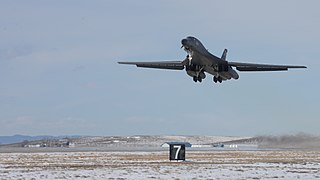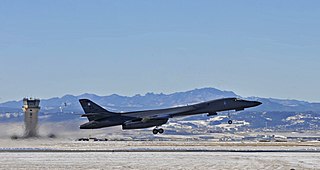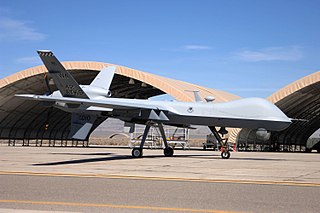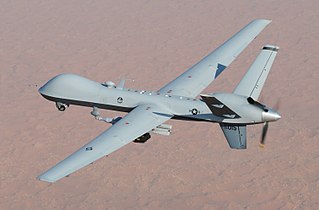
The 95th Reconnaissance Squadron is a squadron of the United States Air Force. It is assigned to the 55th Operations Group, Air Combat Command, stationed at Offutt Air Force Base, Nebraska. The squadron is equipped with several variants of the Boeing C-135 aircraft equipped for reconnaissance missions.

The 11th Attack Squadron is a United States Air Force unit assigned to the 432d Wing Air Combat Command at Creech Air Force Base near Indian Springs, Nevada. It flies General Atomics MQ-9 Reaper Unmanned aerial vehicles. In 1995 the 11th became the first Remotely Piloted Aircraft (RPA) squadron in the Air Force.

The 17th Attack Squadron is a squadron of the United States Air Force. It is assigned to the 432d Wing, and stationed at Creech Air Force Base in Indian Springs, Nevada. The 17th is equipped with the MQ-9 Reaper.

The 42nd Attack Squadron is a United States Air Force unit assigned to the 25th Attack Group located at Creech Air Force Base near Indian Springs, Nevada. It flew the General Atomics MQ-9 Reaper unmanned aerial vehicle. The 42nd oversaw the training and combat deployment of aerial vehicle and sensor operators assigned to the Reaper.

The 34th Bomb Squadron is part of the 28th Bomb Wing at Ellsworth Air Force Base, South Dakota. It operates Rockwell B-1 Lancer aircraft providing strategic bombing capability.

The 37th Bomb Squadron is part of the 28th Bomb Wing at Ellsworth Air Force Base, South Dakota. It operates Rockwell B-1 Lancer aircraft providing strategic bombing capability.

The 25th Attack Group is an active United States Air Force unit, stationed at Shaw Air Force Base, South Carolina. It was activated in February 2018 as a geographically separate unit to operate unmanned aerial vehicles and is assigned to the 432d Wing, which is located at Creech Air Force Base, Nevada. As of 2020, the group manages five General Atomics MQ-9 Reaper attack squadrons, as well as the 25th Operations Support Squadron, which provides intelligence, weather, and administrative support.

The 867th Attack Squadron is an active United States Air Force unit. It was reactivated at Creech Air Force Base, Nevada, on 10 September 2012 as a remotely piloted aircraft squadron.

The 22nd Attack Squadron is a United States Air Force unit assigned to the 432d Wing Air Combat Command at Creech Air Force Base near Indian Springs, Nevada. It flies General Atomics MQ-9 Reaper Unmanned aerial vehicles.

The 429th Attack Squadron is a classic associate squadron, stationed at Holloman Air Force Base, New Mexico. It is geographically separated from its parent 926th Wing at Nellis Air Force Base, Nevada.

The 28th Operations Group is the flying component of the United States Air Force 28th Bomb Wing, stationed at Ellsworth Air Force Base, South Dakota.

The 489th Attack Squadron is an active United States Air Force unit, stationed at Creech Air Force Base, Nevada, and operating MQ-1 and MQ-9 unmanned aerial vehicles. It was active at Beale Air Force Base, California as the 489th Reconnaissance Squadron from 2011 to 2015.

The 29th Attack Squadron is a remotely piloted vehicle training unit of the United States Air Force. Assigned to the 49th Operations Group, 49th Wing at Holloman Air Force Base, New Mexico. Flying the General Atomics MQ-9 Reaper. It was activated on 23 October 2009.

The 50th Attack Squadron is a squadron of the United States Air Force, stationed at Shaw Air Force Base, South Carolina, where it operates the General Atomics MQ-9 Reaper unmanned aerial vehicle. It is assigned to the 25th Attack Group, also at Shaw, and is a component of the 432d Wing, located at Creech Air Force Base, Nevada.

The 394th Combat Training Squadron was a United States Air Force unit assigned to the 509th Operations Group until inactivated on 13 April 2018. It was stationed at Whiteman Air Force Base, Missouri. The mission of the squadron was to train Northrop Grumman B-2 Spirit aircrews, a mission now executed by the 13th Bomb Squadron. The 394th is the fourth oldest squadron in the United States Air Force. Its history dated to 5 May 1917 as the 4th Aero Squadron.

The 46th Expeditionary Reconnaissance Squadron is an active Central Command unit of the United States Air Force.

The 718th Bombardment Squadron is an inactive United States Air Force unit. It was last assigned to the 4128th Strategic Wing at Amarillo Air Force Base, Texas, where it was inactivated on 1 February 1963.

The 482d Attack Squadron is a United States Air Force unit, stationed at Shaw Air Force Base, South Carolina, where it is an operational squadron of the 25th Attack Group, operating the General Atomics MQ-9 Reaper unmanned aerial vehicle.

The 22d Intelligence Squadron is a non-flying squadron of the United States Air Force. It is assigned to the 691st Intelligence, Surveillance and Reconnaissance Group, Fort George G. Meade, Maryland.

The 731st Expeditionary Attack Squadron is a provisional unit of the United States Air Force. It was activated circa 4 March 2021 at the Romanian Air Force 71st Air Base in Câmpia Turzii. The unit is part of the 31st Expeditionary Operations Group and operates General Atomics MQ-9 Reaper unmanned aerial vehicles.




























